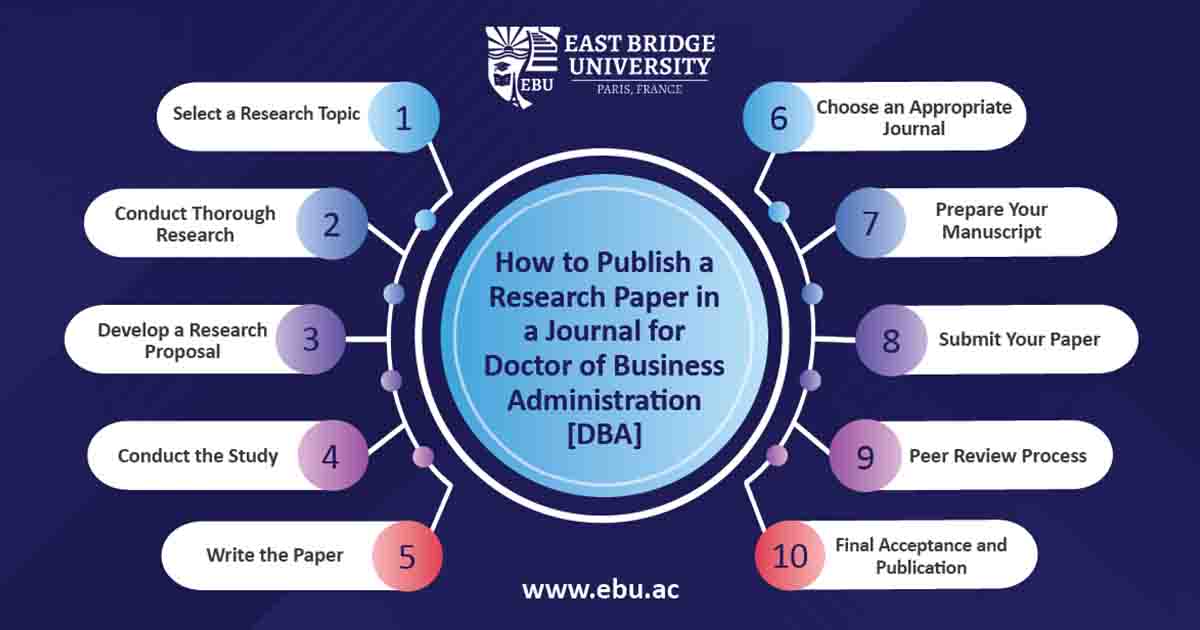Understanding a Doctor of Business Administration (DBA)
A Doctor of Business Administration (DBA) is a specialized degree targeted at working individuals with considerable experience who are keen on expanding their career scope and emerge as thought leaders in their respective fields. The doctorate degree in business administration is one of the highest levels of qualifications in the business world.
The dba business degree provides researchers with in-comprehensive industry familiarity and expertise. They are exposed to wide-ranging academic works while pursuing a DBA. They are expected to make use of those theories and concepts to solve real-world problems and develop strategies that help address problems in the business world. An online doctorate of business administration program combines their vast professional experience with their analytical skills to produce original research papers, making them leading experts in their particular domains.
In today’s day and age of data and information, a Doctor of Business Administration has emerged as a valuable qualification as more organizations seek experts in specific fields with extensive knowledge to analyze data and bring in new insights that help solve industry-specific problems.
Who is Most Suited for a Doctor of Business Administration Program?
A Doctor of Business Administration is perfect for professionals already working in the industry who have considerable expertise and are now looking to enhance their careers and gain a deeper understanding of their particular professional fields.
It is ideal for Senior Executives and people from Senior Management of organizations who are willing to hone their practical skills and professional experience by developing new business strategies and models through research and academic study.
Specializations Offered
East Bridge University offers two flexible pathways for completing its DBA degree programs: DBA by Coursework & Research and DBA by Publication, allowing students to tailor their educational journey to their preferences and goals.
1. Doctor of Business Administration by Research
The Doctor of Business Administration (DBA) by Research is pursued by professionals working in specific business domains who have considerable years of experience. The DBA by Research program aims to equip students with the knowledge and ability to solve real-world business issues and challenges while contributing to the existing knowledge and scholarly theories in specific fields.
2. Doctor of Business Administration by Publication
The Doctor of Business Administration by Publication is a program suitable for individuals with substantial professional experience who have made considerable contributions in the field of business through published research works. Candidates applying for a DBA by Publication typically need to demonstrate their ability to apply theoretical business knowledge to practical real-world solutions.
How to Publish a Research Paper in a Journal for DBA
Publishing a research paper as part of a Doctor of Business Administration (DBA) program involves a structured and meticulous process. Here are the key steps elaborated:
Select a Research Topic
Choosing a topic is the first crucial step. It must be:
- Relevant: Make sure that the topic addresses current issues or emerging trends in business administration.
- Original: Your research should bring new insights or perspectives.
- Significant: The topic should have real-world implications and enrich the field
Tips:
- Consult with Advisors and Peers: Engage with your academic mentors and colleagues to brainstorm potential topics and get their input on the relevance and originality of your ideas.
- Review Recent Publications: Look at recent issues of leading business journals to identify gaps in the research that you can address.
- Attend Conferences: Participate in academic and industry conferences to stay updated on the latest trends and network with other researchers.
Conduct Thorough Research
Engage in an extensive literature review to understand the existing body of knowledge. Use academic databases such as:
- Google Scholar
- JSTOR
- University Libraries
Steps:
- Identify Key Literature: Find seminal papers and recent studies that are foundational to your topic.
- Evaluate Sources: Assess the credibility, relevance, and impact of each source on your topic.
- Synthesize Information: Summarize and integrate findings from various sources to form a comprehensive view of the current research landscape.
Tips:
- Use Reference Management Tools: Tools like EndNote or Zotero can help organize your references and ensure proper citation formatting.
- Create a Literature Map: Visualize the relationships between different studies and identify key themes and gaps.
Develop a Research Proposal
Outline your research plan in a proposal. This includes:
- Research Question: Clearly define what you aim to investigate.
- Hypothesis: State your expected findings or outcomes.
- Methodology: Describe your research design, data collection, and analysis methods.
- Contributions: Explain the potential impact of your research on theory and practice.
Steps:
- Draft Your Proposal: Write a detailed outline covering all necessary components.
- Seek Feedback: Present your proposal to your advisor and possibly a review committee.
- Refine Based on Feedback: Make revisions based on the feedback to strengthen your proposal.
Tips:
- Be Clear and Concise: Ensure your proposal is easily understandable and clearly outlines your research plan.
- Highlight Novelty: Emphasize what makes your research unique and how it fills existing gaps.

Conduct the Study
This phase involves data collection and analysis:
- Data Collection: Gather data through methods such as surveys, interviews, experiments, or secondary data analysis.
- Analysis: Use appropriate statistical or qualitative methods to analyze the data.
Steps:
- Design Your Data Collection Instruments: Develop surveys, questionnaires, or other tools necessary for data collection.
- Pilot Testing: Conduct a pilot test to refine your instruments and ensure they effectively capture the required information.
- Collect Data: Implement your data collection plan systematically to gather reliable data.
- Analyze Data: Use software tools like SPSS, R, or NVivo to analyze quantitative or qualitative data.
Tips:
- Maintain Rigorous Standards: Ensure your data collection methods are reliable and valid to enhance the credibility of your findings.
- Document Your Process: Keep detailed records of your methodology and data collection process for transparency and reproducibility.
Write the Paper
A well-structured paper typically includes:
- Title: Concise and descriptive, reflecting the core focus of your research.
- Abstract: A brief summary of your research question, methods, results, and conclusions.
- Introduction: Contextualizes your study, stating its significance and objectives.
- Literature Review: Summarizes existing research related to your topic, highlighting gaps your study addresses.
- Methodology: Detailed description of your research design, data collection, and analysis methods.
- Results: Presentation of your findings with appropriate use of tables, charts, and graphs.
- Discussion: Interpretation of results, discussing implications, limitations, and suggestions for future research.
- Conclusion: Summarizes the main findings and their significance.
- References: Proper citation of all sources used in your research.
Steps:
- Draft Each Section: Write detailed drafts of each section, ensuring clarity and coherence.
- Revise and Edit: Review your drafts for logical flow, consistency, and adherence to journal guidelines.
- Seek Feedback: Share your drafts with peers and advisors for constructive feedback.
- Finalize the Manuscript: Incorporate feedback and refine your manuscript for submission.
Tips:
- Adhere to Journal Guidelines: Follow the specific formatting and style guidelines of the journal you intend to submit to.
- Be Clear and Concise: Use clear, concise language to articulate your findings and arguments.
Choose an Appropriate Journal
Select a journal that aligns with your research topic and audience. Consider the journal’s impact factor, review process, and publication timelines. Some well-regarded journals in business and management include:
- Journal of Business Research
- Harvard Business Review
- Academy of Management Journal
- Journal of Management Studies
Tips:
- Match Scope and Aims: Ensure your research fits within the scope and aims of the journal.
- Review Previous Issues: Look at past issues to understand the type of articles the journal publishes.
- Consider Impact Factor: Higher impact factor journals often have more rigorous review processes but can significantly enhance the visibility of your research.
Prepare Your Manuscript
Follow the submission guidelines of your chosen journal meticulously. Pay attention to:
- Formatting: Adhere to the required formatting style, such as APA, MLA, or Chicago.
- Word Limits: Ensure your manuscript is within the word limit specified by the journal.
- Citation Styles: Use the correct citation style consistently throughout your paper.
Tips:
- Use Reference Management Tools: Tools like EndNote or Zotero can help manage your references and format citations correctly.
- Proofread Thoroughly: Ensure your manuscript is free of grammatical and typographical errors.
Submit Your Paper
Submit your manuscript through the journal’s submission portal. This typically involves:
- Creating an Account: Register with the journal’s submission system.
- Uploading Your Manuscript: Follow the submission process to upload your document and any supplementary materials.
- Cover Letter: Include a cover letter briefly describing your study and its significance.
Tips:
- Follow Instructions Carefully: Adhere strictly to the journal’s submission guidelines.
- Track Your Submission: Keep track of your submission status through the journal’s portal.
Peer Review Process
Your paper will undergo a peer review process where experts in the field evaluate it for quality, originality, and contribution. Be prepared for:
- Revisions: Respond to reviewers’ comments and make necessary revisions.
- Rejection: If your paper is rejected, consider the feedback, revise your paper, and submit it to another journal.
Tips:
- Be Open to Feedback: Constructive criticism can significantly improve your paper.
- Respond Promptly: Address reviewers’ comments and resubmit your revised manuscript within the stipulated time.
Final Acceptance and Publication
Once your paper is accepted, it will go through the final stages of editing and formatting before publication. You may be required to:
- Proofread the Final Version: Ensure the final version is free of errors and formatted correctly.
- Complete Author Agreements: Sign any required author agreements or copyright forms.
Tips:
- Celebrate Your Achievement: Publishing a paper is a significant milestone in your academic and professional career.
- Promote Your Work: Share your published paper with your network and on professional platforms to maximize its impact.
Conclusion
Publishing a research paper as a DBA candidate is a significant accomplishment that contributes to your professional development and the broader business community. By following these steps, you can navigate the complex process of academic publishing and share your valuable insights with the world.
If you’re ready to elevate your career and make a meaningful impact in the business world, consider pursuing a Doctor of Business Administration [DBA] and start working on your research paper today. The journey may be challenging, but the rewards are well worth the effort.
Written By : Philip Campbell





